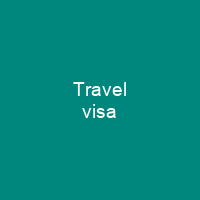A visa is a conditional authorization granted by a territory to a foreigner, allowing them to enter, remain within, or to leave that territory. A visa is subject to entry permission by an immigration official at the time of actual entry, and can be revoked at any time. The modern visa may be a sticker or a stamp in the passport, or may take the form of a separate document or an electronic record.
About Travel visa in brief

The relatively high speed and large movements of people travelling by train would have caused bottlenecks if regular passport controls had been used. Passports and visas became usually necessary as travel documents only after World War I. Some countries—such as those in the Schengen Area—have agreements with other countries allowing each other’s citizens to travel between them without visas. Uniquely, the Norwegian special territory of Svalbard is an entirely visa-free zone under the terms of the SValbard Treaty. In the modern world, visas have become separate secondary travel documents, with passports acting as the primary travel documents. Some visas can be granted on arrival or by prior application at the country’s embassy or consulate, or through a private visa service specialist who is specialized in the issuance of international travel documents,. These agencies are authorized by the foreign authority, embassy, or consulate to represent international travellers who are unable or unwilling to travel to the embassy and apply in person. The issuing authority, usually a branch of the country’s foreign ministry or department, and typically consular affairs officers, may request appropriate documentation from the applicant. This may include proof that the person hosting the applicant is able to support himself in the host country, proof that he or her really exists and has sufficient room for room for his or her home, etc. Other countries ask for proof of health status, especially for some persons with certain illnesses, such as AIDS.
You want to know more about Travel visa?
This page is based on the article Travel visa published in Wikipedia (as of Dec. 02, 2020) and was automatically summarized using artificial intelligence.







